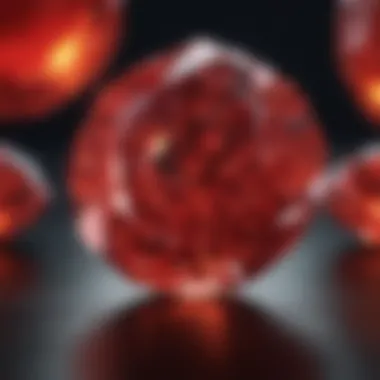Exploring the Varieties of Red Crystals and Their Significance


Intro
The realm of red crystals captures the imagination of many. These vibrant gemstones stand out due to their rich colors and intriguing properties. Understanding these stones transcends mere aesthetics; it connects individuals to historical traditions, cultural symbols, and metaphysical beliefs. As we dive deeper into the world of red crystals, we will explore their characteristics, significance, and practical uses.
Gemstone Overview
Definition and Characteristics
Red crystals are naturally occurring minerals that exhibit a red hue due to various chemical and physical properties. The coloration can be attributed to the presence of specific elements, such as iron or chromium. Red stones, often found in various shades from deep crimson to bright ruby, serve multiple purposes, ranging from decorative to therapeutic. Their hardness, clarity, and luster vary widely, affecting their desirability and value in the market.
Classification of Gemstones
Gemstones can be classified into two main categories: precious and semi-precious. Precous gemstones typically include rubies, garnets, and spinels due to their rarity and high value. Semi-precious stones, while still beautiful, are more abundant and include types like jasper and coral. Each classification holds different attributes and cultural significances, ensuring that there is a broad spectrum for collectors to choose from.
Properties of Gemstones
Physical Properties
Physical properties are crucial for identifying and evaluating red crystals. Key physical characteristics include:
- Hardness: Measured on the Mohs scale, determining a stone's resistance to scratching.
- Color: The intensity of the red can vary based on the type of crystal.
- Transparency: Crystals can range from transparent to opaque, influencing their aesthetic appeal.
- Luster: This describes how light interacts with a gemstone's surface, impacting its sparkle and shine.
Chemical Properties
The chemical makeup of red crystals is essential for their classification and identification. Common elements found in red gemstones include:
- Aluminum: Found in rubies and garnets.
- Iron: Often responsible for the red color in jasper and garnets.
- Magnesium: Present in spinels, contributing to color variation.
- Silica: A component of many crystalline structures, providing stability.
"Understanding the chemical foundation of red crystals enriches both their appreciation and their proper handling in jewelry design and collection."
Intro to Red Crystals
Red crystals are not just beautiful; they possess depth and richness that have fascinated humans for centuries. Understanding red crystals provides insights into both their physical properties and their cultural significance. These gemstones, including varieties like ruby, garnet, and carnelian, hold a place of honor in diverse cultures worldwide. Each type possesses unique characteristics that set them apart, influencing their demand and application.
Definition and Characteristics
Red crystals are defined by their striking hue, which can range from deep crimson to bright scarlet. The color is primarily a result of the presence of chromium, iron, or manganese within their chemical composition. For instance, the intense red of a ruby comes from chromium, while garnets exhibit a wider spectrum influenced by various elements.
These crystals also differ in hardness and clarity. For example, rubies are among the hardest gemstones, scoring 9 on the Mohs scale, making them suitable for everyday wear. In contrast, some garnets may score lower, impacting their use in jewelry. Clarity plays a crucial role in value; transparent stones are generally more sought after than opaque ones.
Also significant are the unique inclusions that often tell a story of the crystal's journey. Discovering these traits is essential for gemologists and collectors alike, as they not only influence the stone's aesthetic but also its market value.
Historical Significance
Red crystals have played crucial roles throughout history and across cultures. The ruby, often deemed the "king of gemstones," was coveted by ancient civilizations like the Romans and in Asia. It symbolized power, passion, and protection in numerous traditions. Monarchs and elites wore rubies, believing they bestowed strength and courage.
Garnets, too, have notable historical roots. The gem is frequently associated with the medieval period. They were believed to protect the wearer during travel and were often included in burial artifacts.
Cultural beliefs surrounding these stones extend to modern spirituality, where red crystals are linked to vitality, love, and passion. Their use in various jewelry types also serves as a status symbol, making them part of both everyday and ceremonial attire.
Understanding the historical context of red crystals deepens our appreciation of their value today. Their allure is not just about beauty; it encapsulates a rich tapestry of human history.
Types of Red Crystals
Red crystals are not only visually stunning but carry their own individual characteristics and significance. Understanding the various types of red crystals is crucial as they serve different aesthetic, cultural, and metaphysical needs. Each type stands out due to its unique physical properties, sources, and the cultural importance it embodies.
Ruby
Physical Properties
Ruby, known for its vibrant red hue, is a variety of corundum. The key characteristic of ruby's physical properties is its hardness, rated 9 on the Mohs scale, making it highly durable. This durability contributes greatly to its desirability in jewelry. Rubies can display a strong fluorescence under UV light which enhances their red color. However, this distinct luminescence can also make it more challenging to accurately evaluate a ruby's quality in certain lighting.
Sources and Formation


Rubies primarily form in metamorphic rocks under specific heat and pressure conditions. Major sources include Myanmar, Thailand, and more recently, Africa. The uniqueness of each ruby varies based on the region of origin, with Myanmar rubies famed for their deep red color. However, sourcing can be complex, as the quality varies significantly, leading to price variations.
Cultural Significance
Historically, rubies have been symbols of love and passion. In many cultures, they were believed to possess protective powers. They are often associated with prosperity and success, making them a popular choice for special occasions like weddings. Their reputation as "the king of gemstones" highlights their esteemed place in gemology.
Garnet
Physical Properties
Garnets, while generally known for their reddish tones, can come in a variety of other colors. The most significant aspect of garnet's physical properties is their range in hardness, between 6.5 and 7.5 on the Mohs scale. This makes them suitable for various applications, including both jewelry and industrial purposes. However, their variability in hardness can affect their choice for specific uses.
Sources and Formation
Garnets form in metamorphic rocks and are widely sourced from regions like India, Sri Lanka, and Africa. The diverse geographical origins result in different garnet types. For instance, almandine garnets are found predominantly in the United States, whereas pyrope garnets are often found in Africa. This diversity offers collectors a rich array of options, but sourcing specific types can present challenges depending on market demand.
Cultural Significance
Culturally, garnets have been tied to vitality and energy. They are often associated with protection during travel and are considered a stone of commitment. This cultural symbolism adds depth to their appeal, which has contributed to a strong presence in jewelry and gift-giving traditions through the ages.
Red Spinel
Physical Properties
Red spinel is often mistaken for ruby due to its similar appearance, but its physical properties set it apart. Spinels are rated 7.5 to 8 on the Mohs scale, providing them with good durability. Their clarity and brilliance contribute to their popularity, though their availability can be limited compared to other gemstones. This unique quality can pose both advantages and challenges when sourcing.
Sources and Formation
Spinel forms in metamorphic and igneous rocks and is sourced from regions such as Myanmar and Sri Lanka. It is less common than other red gemstones, which enhances its value among collectors. The rarity of high-quality red spinel can complicate the supply chain, leading to issues related to ethical sourcing practices.
Cultural Significance
Red spinel has been celebrated throughout history, often referred to as the “gem of the kings.” Its significance lies in its ability to convey strength, making it a favored stone among not only collectors but also in royal jewelry. This royal lineage bolsters its desirability, though it may not carry the same mainstream recognition as ruby or garnet.
Carnelian
Physical Properties
Carnelian is a form of chalcedony and is characterized by its rich, warm hues ranging from orange to deep red. One prominent feature of carnelian is its translucent quality, which contributes to its striking appearance. Rating between 6 and 7 on the Mohs scale, it is a relatively hardy option for various applications. However, the lower hardness may limit its use in certain types of jewelry.
Sources and Formation
Carnelian is typically found in sedimentary deposits, and major sources include Brazil, India, and the U.S. The ease of access to carnelian makes it quite popular, but its abundance can sometimes lead to misconceptions about its value. While carnelian is widely available, finding high-quality specimens can still present challenges in the market.
Cultural Significance
In a variety of cultures, carnelian is regarded as a stone of motivation and endurance. It has been utilized for centuries in jewelry and talismans. Its vibrant color and historical roots give carnelian a unique spot in the pantheon of gemstones, representing longevity and courage for many tribes.
Tourmaline
Physical Properties
Tourmaline is a complex boron silicate mineral that exhibits a wide array of colors, with red varieties being particularly sought after. Its hardness rating ranges from 7 to 7.5 on the Mohs scale, offering good durability. The unique electrical properties of tourmaline also add to its intrigue. While not as consistently red as other gemstones, the striking variations make it appealing to collectors. Its variability can sometimes lead to confusion over identification.
Sources and Formation
Tourmaline forms in igneous and metamorphic rocks, with rich deposits found in Brazil, Afghanistan, and the United States. The complexity of its crystal structure often leads to variations in quality and appearance. Consequently, sourcing genuine red tourmaline can require careful attention to detail.
Cultural Significance
Tourmaline holds a significant place in various cultures as it is believed to protect against negative energies. The different colors of tourmaline, including red, are often tied to balancing energies within the body. This characteristic has made it a favored stone in metaphysical practices and self-care.
Red crystals are not only visually captivating; they each deliver unique contributions to gemology. Understanding their distinct properties, formation, and cultural importance enhances both appreciation and informed decisions in the world of gemstones.
Metaphysical Properties of Red Crystals


Metaphysical properties hold a significant place in the realm of gemstones. Red crystals, in particular, are often associated with vitality, passion, and the essence of life itself. These properties can enhance our personal well-being and provide spiritual advantages. They are believed to resonate with the energy of the root and heart chakras, promoting stability and emotional balance. This section explores the various metaphysical attributes and the profound benefits they can offer to their users.
General Benefits
The benefits of red crystals extend beyond mere aesthetics. Many enthusiasts and practitioners of crystal healing find that these stones can aid in:
- Enhanced Energy Levels: The vibrant red hue is thought to be invigorating, helping to uplift one’s physical and emotional state.
- Courage and Strength: These crystals are often used to instill confidence and resilience in the face of challenges, making them popular among individuals seeking motivation.
- Connection to the Earth: Red crystals evoke a grounded feeling, which can enhance one’s connection to nature and physical surroundings.
Overall, the metaphysical properties of red crystals may assist individuals in navigating through life’s complexities by allowing them to harness their inner strength and energy.
Impact on Emotions
Emotional well-being is often intertwined with the energies we surround ourselves with. Red crystals can play a role in managing our emotional landscapes:
- Passion and Love: They often deepen romantic and interpersonal relationships, enhancing feelings of love and passion.
- Emotional Release: These crystals can serve as a tool for releasing pent-up emotions, allowing for a healthier emotional state.
- Mood Stabilization: Many users report that red crystals assist in alleviating feelings of stress and anxiety, promoting overall emotional stability.
These impacts suggest that red crystals can facilitate a better understanding of oneself and foster meaningful connections with others.
Healing Properties
In the context of healing, red crystals are considered powerful allies. They are often employed in various practices to enhance physical and mental health:
- Circulatory System Support: Some believe that red crystals can help improve blood circulation, promoting physical vitality.
- Energy Realignment: They are thought to assist with energy blockages, helping to restore physical and emotional harmony in the body.
- Stress Relief: Users have found that red crystals can alleviate stress-related symptoms, contributing to a sense of overall well-being.
In summary, the healing properties associated with red crystals offer support on multiple levels, targeting both the emotional and physical aspects of life.
"The essence of red crystals transcends their physical beauty, providing benefits that enrich the spirit and stabilize the mind."
By understanding these metaphysical properties, gemstone enthusiasts can appreciate the deeper connections these fascinating stones foster within themselves and the world around them.
Identification of Quality Red Crystals
Identifying quality red crystals is crucial for various reasons, especially for gemstone enthusiasts and collectors. Knowing how to distinguish high-quality stones from inferior ones can significantly influence purchasing decisions. It helps ensure that the investment made in these gems is justified. Additionally, knowing about the quality can enhance the appreciation of the stone’s beauty and its intrinsic value. In this section, we will explore visual inspection techniques, the use of gem testing tools, and the understanding of gemstone grading.
Visual Inspection Techniques
Visual inspection is the first step in identifying the quality of red crystals. When examining a red gemstone, certain characteristics should be noted. Look for clarity, color saturation, and cut precision.
- Clarity: A gemstone should be free from visible inclusions. Any imperfections may diminish its value.
- Color Saturation: High-quality red crystals should have a rich color. Inspect under different light conditions to see the true hue.
- Cut: The craftsmanship of the cut affects how light interacts with the stone. A well-cut stone reflects light beautifully, enhancing its brilliance.
This inspection should ideally be done under natural light. Using a jeweler's loupe can help in making finer observations.
Utilizing Gem Testing Tools
Various gem testing tools can aid in identifying the quality of red crystals more accurately. These tools provide a deeper analysis that mere visual inspection cannot achieve. Some commonly used tools include:
- Refractometer: Measures the refractive index of the stone.
- Spectroscope: Analyzes the light spectrum to identify the mineral composition.
- Hardness Tester: Evaluates the Mohs hardness of the crystal, helping distinguish between similar-looking stones.
Utilizing these tools allows for a more scientific approach in identifying the authenticity and quality of red crystals. They provide data that can confirm visual findings and ensure a wise purchase.
Understanding Gemstone Grading
Understanding gemstone grading is vital to assess quality more effectively. Grading systems evaluate crystals based on various criteria, including:
- Color Quality: The hue, saturation, and tone are all considered.
- Clarity Rating: Rated from flawless to included based on visible inclusions.
- Cut Quality: Graded on the precision of the cut and how well it reflects light.
- Carat Weight: Heavier stones often command higher prices, but this should be balanced with other quality indicators.
By comprehending these grading standards, collectors and enthusiasts can better evaluate red crystals in the market. It helps them understand what affects a stone’s value and why certain stones are more pricey than others.
"Quality red crystals require careful assessment to fully appreciate their value and beauty. Proper identification is about more than aesthetics; it involves knowledge and expertise."
This structured approach to identifying quality red crystals ensures that potential buyers are well informed and can make decisions that reflect their appreciation for these remarkable gemstones.
Ethical Sourcing of Red Crystals


Ethical sourcing of red crystals is a critical consideration for gem enthusiasts and collectors alike. As the demand for these stunning gemstones grows, it is essential to shed light on the practices surrounding their acquisition. Ethical sourcing ensures that crystals are obtained in a manner that respects both people and the environment. This aspect not only enhances consumer awareness but also encourages responsible practices within the gemstone industry.
Understanding Ethical Sourcing
Understanding ethical sourcing involves examining how red crystals are mined, processed, and sold. Mining practices can vary significantly. Some operations may prioritize the welfare of workers and the sustainability of local communities. Others might not uphold those principles, leading to exploitation and environmental degradation.
Ethical sourcing emphasizes transparency in the supply chain. Buyers should be informed of where and how their red crystals are sourced. This aspect is crucial in building trust and fostering a conscientious consumer base. Moreover, ethical sourcing aligns with a broader commitment to sustainability, promoting practices that minimize environmental impact and support local economies.
Impact of Conflict Stones
The term "conflict stones" refers to gems that are mined in war zones or traded under unethical circumstances, often financing violent conflicts. Red crystals, like rubies and garnets, can sometimes fall into this category. The implications of purchasing these stones can be profound, underscoring the need for vigilance in sourcing.
Consumers who opt for ethically sourced red crystals can help combat these conflicts. By choosing gemstones that support fair labor practices and contribute positively to communities, buyers can make a statement against conflict stones. This responsible choice can lead to significant change in the gemstone trade, promoting human rights and ethical standards.
"When purchasing gemstones, understanding their origin is as vital as appreciating their beauty."
Choosing Certified Sources
Choosing certified sources for red crystals is a practical step toward ethical consumption. Certified dealers often adhere to specific standards regarding mining and trading practices. Such certifications may include Fair Trade, the Gemological Institute of America (GIA), or similar organizations that promote ethical guidelines.
When selecting red crystals, you can look for dealers who are transparent about their sourcing. This information can include details on how crystals are mined, the conditions under which workers operate, and the impact of mining on the environment.
Here are some tips for choosing certified sources:
- Verify the credentials of the dealer.
- Ask for documentation related to the gemstone's origin.
- Research the organization's standards and ethical practices.
- Stay informed about current issues regarding gemstone sourcing.
By intentionally selecting certified sources, consumers contribute to a market that values human dignity and environmental stewardship. This choice not only benefits individuals but also supports a more ethical and sustainable gemstone industry.
Applications of Red Crystals
Red crystals serve a variety of important functions, especially in the realms of jewelry making, collecting, investment, and metaphysical practices. Understanding these applications can enhance appreciation for these unique stones and guide choices in their use. Each application allows for engagement with the crystals on different levels, whether for personal adornment, investment decisions, or spiritual purposes.
Jewelry Making
Jewelry making is one of the most prominent uses of red crystals. Gems like rubies, garnets, and tourmalines are often featured in necklaces, rings, and bracelets. The vibrant color of these crystals makes them highly sought after for artisans and consumers alike. These stones can elevate a piece of jewelry, adding not only aesthetic value but also cultural significance.
The durability of red crystals plays a crucial role in their selection for jewelry. For example, rubies, known for their hardness and stunning hue, are often embedded in high-end pieces. Furthermore, red crystals can be used in various styles ranging from classic to avant-garde designs. The versatility ensures that they appeal to a broad demographic, enabling jewelry designers to experiment with varied techniques and settings.
In terms of market value, jewelry made with red crystals is often considered a worthwhile investment. The popularity of gems such as ruby remains steady, ensuring ongoing interest. This can give jewelry designers a reliable market, as consumers are willing to pay a premium for unique, quality pieces.
Collecting and Investment
Collecting red crystals can be a rewarding endeavor that may also offer financial return. Certain species, like the ruby or natural garnet, can appreciate significantly over time. Collectors often look for specific characteristics, such as clarity, size, and provenance. Understanding the grading system of gemstones aids collectors in making informed choices.
Moreover, red crystals often come with a fascinating history that can enhance their appeal. Those with rare origins or unique formation processes tend to hold higher value. Collectors often network through forums or groups like those found on reddit.com to exchange information and potentially lucrative opportunities.
Investing in red crystals requires careful consideration. It is vital to source specimens from reputable dealers and to gather paperwork certifying authenticity. Investing in gems can turn into a profitable hobby, as long as individuals remain diligent.
Metaphysical Practices
The metaphysical properties associated with red crystals are a significant draw for many. They are often believed to enhance energy, vitality, and passion. Each stone possesses its unique properties, catering to a range of spiritual practices. For example, ruby is associated with love and passion, whereas garnet is thought to bring stability and balance.
Practitioners often use red crystals in meditation sessions, believing that they can align energies within the body. They may place crystals in their environment or wear them as jewelry to maintain a constant energy flow. This practice can provide emotional healing or enhance focus.
Culmination
The importance of concluding an article about red crystals cannot be understated. This section serves to encapsulate the expansive discussion found within the article. It emphasizes understanding the diverse varieties of red crystals, their practical applications, and their unique qualities. Red crystals hold both beauty and significance across various cultures, offering more than mere aesthetics.
Summary of Key Points
This article has covered several crucial aspects surrounding red crystals. Here are the key takeaways:
- Diversity of Crystals: Red crystals encompass a range of types including Ruby, Garnet, and Tourmaline, each with their own specific characteristics and applications.
- Metaphysical Properties: The metaphysical attributes of these crystals are discussed, highlighting their benefits in emotional and physical realms.
- Quality Identification: Techniques for identifying quality red crystals have been addressed, presenting methods for both visual inspection and the use of gem testing tools.
- Ethical Sourcing: The ethical concerns surrounding the sourcing of red crystals are examined, particularly the impact of conflict stones.
- Applications: Red crystals are utilized in many areas like jewelry making and metaphysical practices, revealing their versatile nature.
The Future of Red Crystals in Gemology
Looking ahead, red crystals are likely to retain their allure in the realm of gemology. As technology advances, methods of identifying and assessing these stones will likely improve, making it easier for enthusiasts to procure quality gems. This may lead to a rise in the value of certain red crystals, especially if ethical sourcing continues to gain momentum.
There is ongoing interest in the metaphysical properties of red crystals. The growing community of practitioners and collectors emphasizes their importance for personal and spiritual development. Thus, red crystals will continue to be significant in both the jewelry market and in various holistic practices.
In sum, understanding the multifaceted nature of red crystals not only enhances appreciation for these gemstones but also encourages responsible involvement in their trade and application.



